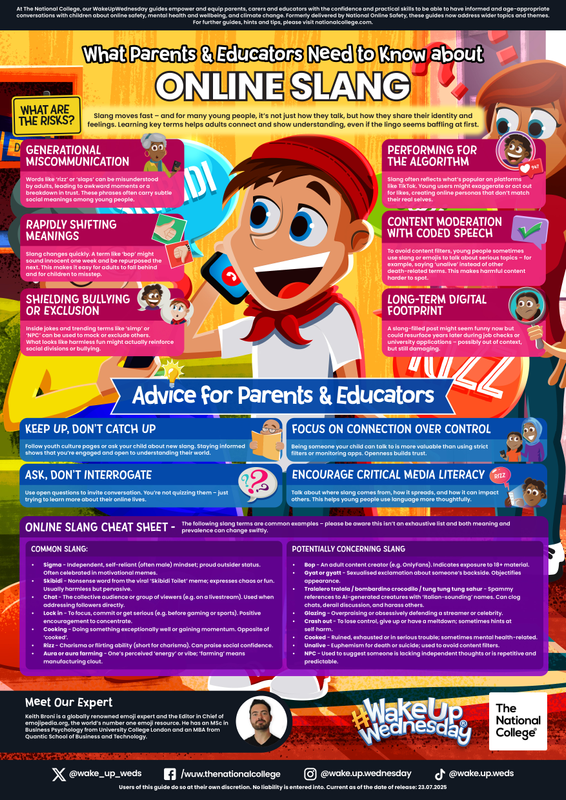Online Safety
Internet Safety
The internet is essential for children's education and social interaction, allowing them to explore and be curious. As they grow, they access various technologies such as social media, games, and apps on different devices. Although the internet offers positive opportunities for learning, it also requires measures to ensure the safety of children. Monitoring online activity through broadband providers can help protect them. For more information on parental controls and internet safety, please see the guide linked below.
Please click on the links below to explore the information to support your knowledge and understanding around online safety and how to keep your child safe.
Please visit our Policies page to view our Online Safety Policy.

Online Slang
Online slang can be a vibrant way for young people to express themselves, but it also changes rapidly and can sometimes carry hidden meanings. This guide helps adults navigate this shifting landscape by breaking down what some of today’s most-used slang terms actually mean and why they matter. From ‘rizz’ to ‘sigma’, it’s a handy starting point for anyone wanting to better understand how young people communicate online.

Online Safety for Under 5s
According to Ofcom’s most recent research, a significant proportion of children are already online by the time they start school, with 17% of 5-year-olds owning their own mobile phone and 50% using messaging platforms. As becoming familiar with technology is generally encouraged in younger children – and has been essential for education during the pandemic – it is essential that trusted adults recognise both the benefits and the risks of infants and toddlers going online. We’ve compiled our top tips to help the under-5s start their online safety journey.
In the guide, you'll find tips such as managing screen time, block in-app purchases and using devices together.

Understanding Emojis
Emojis aren’t just digital decoration — they’re often used as a coded language that young people use to express identity, humour and emotion. Without context, they can easily be misunderstood by adults, leading to confusion or missed signals. Some emojis may even mask risky behaviours or emotional struggles.
This guide helps decode this ever-evolving language, empowering parents and educators to have more open, informed conversations with the children in their care. It also highlights the meaning of some common emojis and offers practical tips for staying clued-in without snooping or suspicion.

Roblox
Whilst they can be a great way for friends to socialise, online games like Roblox that allow multiplayer gameplay with strangers are always fraught with a variety of dangers that can expose children to inappropriate or harmful content. Roblox enables people to play anonymously, which can often be something that attracts people to misuse the game and potentially put young people at risk of harm.
In addition to interacting with random strangers across the world, other factors such as in-game purchases and potential scams can also pose a financial risk. It’s important that parents and educators remain aware of the risks associated with this popular title and how it can be used safely. This guide offers parents and educators expert advice on what can be done to ensure that young people have a safe and enjoyable experience with Roblox.
What you need to know about Roblox - Download PDF
Short (1 minute) video explaining how to set up Parental Controls

Fortnite
Over the years, Fortnite has become a household name in the gaming community. It was one of the first titles in the ‘battle royale’ subgenre, where players are thrown into a chaotic free-for-all on a sprawling map and fight until only one remains. Its cartoonish presentation and satisfying gameplay loop make it a potentially attractive choice for young players.
However, it’s important to remember that online safety risks are always present – especially in multiplayer games – and Fortnite is no exception. This guide, put together with expert input, tells you all you need to know about the safety concerns of this popular title and offers advice on how to protect children and young people as they enjoy the game.

EA Sports
With new kits, updated squads and refined gameplay, EA FC 26 brings the thrill of top-tier football to living rooms once again. While it continues to offer family-friendly fun in modes like Kick-Off and Career, the ongoing popularity of Ultimate Team – where players spend money to build fantasy squads – brings a mix of excitement and risks.
Children can encounter issues such as gambling-like mechanics, voice chat with strangers, and potential exposure to scams. This guide breaks down the game’s most important features, highlights the key risks to be aware of, and shares practical advice for helping young players stay safe while gaming and interacting online.

Traumatic & Challenging Events
This guide offers compassionate, practical advice for helping children cope with traumatic or challenging events – such as bereavement, bullying, or family upheaval – and begin the healing process.
Dealing with Traumatic and Challenging Events - Download PDF

Memes
Memes are everywhere - quick, witty, and wildly shareable. For many young people they are more than jokes, they’re a way to connect, express themselves and interpret the world. But behind the humour, there can be risks. This guide helps adults understand how memes work and why they matter to young people today.

Useful Guides for Popular Apps
Extra Resources for Parents











